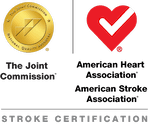24/7 stroke care in Englewood, Florida
When you or a loved one are exhibiting signs of a stroke, finding emergency care close to home is critical. Englewood Community Hospital is an Acute Stroke Ready Hospital, as designated by The Joint Commission. This means that our emergency room (ER) staff is readily available to administer clot-busting stroke treatment 24/7.
If you are experiencing symptoms of a stroke, call 911 immediately. For questions about our emergency stroke care, please call our Consult-A-Nurse® team at (941) 473-3919.
Stroke symptoms
Familiarizing yourself with the signs of a stroke can make all the difference when you need to seek emergency medical treatment. The best way to combat a stroke is to receive emergency care as quickly as possible, so lifesaving medical intervention can be applied. Common stroke symptoms include:
- Dizziness—sudden loss of balance, especially in addition to any of the symptoms listed below
- Headache—sudden severe and unusual headache
- Trouble speaking—sudden difficulty speaking, understanding or confusion
- Vision problems—sudden trouble seeing in one or both eyes
- Weakness—sudden loss of strength or numbness in the face, arms or legs
What happens when you have a stroke
Stroke is a serious, emergency medical condition that requires immediate medical attention. It occurs when blood flow in the brain is altered. There are two types of stroke: hemorrhagic stroke and ischemic stroke.
A hemorrhagic stroke occurs when a blood vessel in the brain ruptures, such as an aneurysm, resulting in bleeding inside the brain. The bleeding causes excessive pressure in the brain, which results in damage to brain cells. When brain cells become damaged, certain affected areas of the brain are no longer able to function as they once did.
An ischemic stroke is similar to a heart attack, in that it is caused by a blockage. This type of stroke results when a blood vessel that supplies blood to the brain becomes blocked. The blockage may occur directly in the blood vessel supplying blood to the brain or can travel from another part of the bloodstream.
Stroke treatment
Medical intervention is required to stop a stroke and prevent excessive damage to the brain. The sooner treatment is administered, the more brain cells can be preserved and the better the long-term outcome.
For an ischemic stroke, the ER physicians at our hospital are able to administer tissue plasminogen activator (tPA). This is a clot-busting drug that targets and breaks up the plaque that is blocking the artery supplying blood to the brain. It is most effective if given within four-and-a-half hours of symptom onset, which is one reason why time is so crucial when stroke symptoms are present.
Hemorrhagic stroke treatment differs from an ischemic stroke and focuses on controlling the bleeding in the brain and reducing the pressure that results from the bleeding. This can be accomplished through medications. In severe cases, surgical treatment may be needed.
Following emergency treatment and intensive medical care, physical therapy and rehabilitation is important for patients to regain strength and relearn activities of daily life.
Effects of stroke
Severe side effects associated with stroke include brain damage. Each stroke will result in a different amount of brain damage, depending on the type of stroke and the length of time before treatment was administered. Brain damage can result in different conditions depending on what hemisphere of the brain was affected: left hemisphere or right hemisphere.
The left hemisphere of the brain allows for logic and analysis and affects tasks such as:
- Number skills
- Reasoning
- Right-hand use
- Scientific function
- Spoken language
- Written language
The right hemisphere of the brain allows for creativity and spatial awareness and affects tasks related to:
- Art awareness
- Creativity
- Insight
- Left-hand use
- Music
- Spatial awareness

